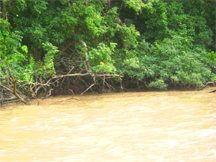-as re-planting projects get underway
New regulations have been put into effect to prohibit the removal of mangroves, while around $125M is expected to be spent this year on restoration projects across the coastland.

The National Agricultural and Research Institute (NARI) will coordinate the technical aspect of the implementation of the restoration project and a Mangrove Management Implementation Committee (MMIC), comprising representatives from 10 agencies relative to the programme, was recently formed to spearhead the groundwork. The agencies include the Guyana Forestry Commission (GFC), the Environmental Protection Agency (EPA), the Guyana Lands and Surveys Commis-sion(GL&SC), the Sea and River Defence Unit and NARI, among others.
While giving the feature address at a stakeholder’s workshop on mangrove restoration at the Cheddi Jagan Research Centre on High Street, Kingston yesterday, Agriculture Minister Robert Persaud stated that monies spent on the restoration programme will cover activities critical to the programme. Among the activities listed by Persaud were effective public awareness programmes, development of nurseries of the tropical shrub at NARI, and community involvement, with much emphasis placed on the latter at the forum.
On this point, Persaud alluded to a recent report carried by Stabroek News, in which residents of Mon Repos on the East Coast of Demerara had disputed the results of a pilot programme carried out by the Sea and River Defence Unit. The Unit had claimed the project to be successful. In this regard, the minister made a special appeal to citizens to recognise the importance of the restoration of mangrove. He announced that earlier yesterday he signed regulations which make the removal of mangroves an offence. The regulations, which are to be incorporated into the Forestry Act, will make provisions for economic use of the plant by relevant individuals.
Persaud told the gathering, which included Public Works Minister Robeson Benn, Head of the Technical Section of the European Union (EU) Chris Ingelbrecht and Region Four Chairman Clement Corlette, that a renewed start has to be made to the mangrove restoration programme, noting that efforts previously made to protect and restore the species cannot be overlooked. In this regard, he stated that the efforts of the Sea Defence Unit now need to be complemented with the pursuit of a more scientific approach.
As he called for “national action” to prevail within the restoration framework, Persaud stated that there is the need for the development of linkages, which includes the involvement of experienced persons within the programme. He said the plan is to develop a comprehensive approach to the project this year, noting that it is an aspect of the implementation of the country’s Low Carbon Development Strategy (LCDS).
He added that the involvement of the 10 agencies within the restoration programme will need some amount of coordination, but he personally believed that when the work of the MMIC would have been exhausted, the Sea Defence Unit should be in a position to “take it into the future.” In terms of climate change, Persaud said that for Regions 4 and 5, the estimated cost to maintain sea defence infrastructure lies in the vicinity of $500M-a figure he noted the authorities cannot garner at this time.
Persaud, while alluding to the vulnerability of Guyana’s coastland to flooding and the high cost to maintain same, stated that there are other “least cost” techniques which the MMIC could examine, listing the cultivation of the Vetiver grass as an option which can be considered.
Public works Minister Robeson Benn told the forum that technical persons attached to the relevant agencies involved in the programme “need to get their hands dirty,” stating that it is “an aversion which has to be overtaken.” While noting that the restoration project is a fundamental task which would make the country sustainable and safe, Benn added that the technical persons have a tendency to “avoid getting out there.” In this context, he stated that there can only be professional satisfaction if the relevant persons are able to point to professional papers, which he noted comes from exposure to the field.
Ingelbrecht, of the EU Delegation to Guyana, stated that the EU is closely following collaborative efforts formed with the government on addressing climate change. He viewed the restoration programme as a “bold step,” stating that there is enough information available for the project to be undertaken. He said that the restoration programme is a budget support project which will supplement the National Mangrove Management Plan.
Ingelbrecht said the “worrying issue” would be coordination of the restoration programme, adding that the “good news is that the government is pro actively involved” in the project. The MMIC is chaired by Annette Arjoon-Martins of the Guyana Marine Turtle Conservation Society (GMTCS), who stated that the project is critical to the protection of the coastland. She said that Guyana has some 370Km of sea defence infrastructure of which 290Km comprises of natural infrastructure which includes mangroves. Arjoon-Martins cited the areas of protection, research and rehabilitation of the tropical shrub as being important, adding that the formation of the MMIC is timely.
Significant sums of monies have been expended and budgeted on the regeneration of mangrove along the coastline over the years but regeneration of the shrub has been met with differing views. Engineer Charles Sohan has stated in letters to this newspaper that previous projects have been tried but failed, the growth of the species being destroyed by the actions of animals, humans and foreshore erosion. He posited that the objective of the authorities should be to pursue sea and river defence infrastructure works of a more stable and permanent nature which have stood the test of time.




